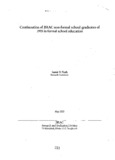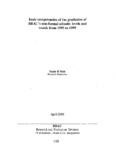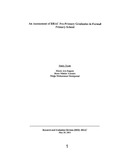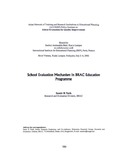| dc.description.abstract | The education programme of BRAC not only provides quality basic education to its learners
it also put emphasis on their enrolment in formal schools for further education. The
Research and Evaluation Division of BRAC started a tracer study on the graduates of BRAC
non-formal schools in 1995. This article, based on the data generated from the tracer study,
explores the continuation of education of the graduates of BRAC non-formal schools in
formal schools. Three types of schools were considered. These are BRAC operated NonFormal
Primary Education (NFPE) and Basic Education for Older Children (BEOC), and
NFPE under Education Support Programme (ESP). A representative sample of 1,259
graduates of 1995, who completed three years course in BRAC schools, was followed up and
surveyed in 1995, 1997 and 1999 to collect various information including their schooling
status. However, in this third survey 1,106 could be traced. The following are the major
[mdings from the third survey round:
1. After graduating from BRAC schools in 1995, 90% children were enrolled in formal
schools for further education (90.4% for boys and 89.9% for girls).
2. On average, around 10% of the graduates dropped out from the formal systems per year.
Highest dropout occurred during the second year of formal schooling (16.6%). Up to
October 1999, 39.6% of the graduates were continuing education in different formal
schools .
3. There was no gender gap at the time of entering the formal schooling but boys dropout
increased from the second year. In October 1999, 33% of the boys and 42.3% of the
girls was continuing education in formal schools.
4. A higher proportion of children of NFPE continued education in formal schools than
children of BEOC and NFPE-ESP.
5. The children who graduated from NFPE generally enrolled in Class IV or V, and the
graduates of BEOC mostly enrolled in class V or VI. Some children enrolled in class III
even they completed three years curriculum in BRAC schools.
6. Over three-quarters of the graduates of 1995 completed five-year cycle of primary
education by 1998 (69.1% for boys and 79% for girls). School-wise 78.2% of NFPE,
70.4% of BEOC and 65.2% of NFPE-ESP completed primary cycle.
7. The relationship between survival rate and grade of entry in formal schools was negative.
The survival rate was highest among those enrolled in class IV (50.6%), less among
those enrolled in Class V (42.2%) and least among those enrolled in Class VI or more
(33.1%).
8. After graduating from BRAC schools the children mostly got enrolled in government
primary schools (70.7%) and non-government high schools (17.5%). After about four
4
255
years of their graduation, among the children who survived in formal schools up to early
1999 85.6% were found in non-government high schools.
9. Proportion of graduates enrolled in Madrassas was 4.5% in 1995. Among the children
who survived up to early 1999,11.4% were in such type of schools.
10. Two major causes of dropout was 'scarcity of money' (39.1%) and'marriage'.(40.1%).
For boys dropout, the major reasons were 'scarcity of money' (65.3%), 'disliking for
school' (16.4%), and 'has to work at home or outside' (12%). For girls two major
reasons included 'marriage' (59.2%) and 'scarcity of money' (26.5%).
11. Demographic and socio-economic characteristics played significantly important role in
continuation of education. Younger children were more likely to continue for longer
period than older children. Parental education has significant positive relationship with
survival rate. The survival rate decreased from 83.3% in early 1995 to 24.6% in October
1999 among the children came from the households eligible for BRAC rural
development programme. However, these rates were respectively 93.7% and 47.4%
among those came from non-eligible households. | en_US |




